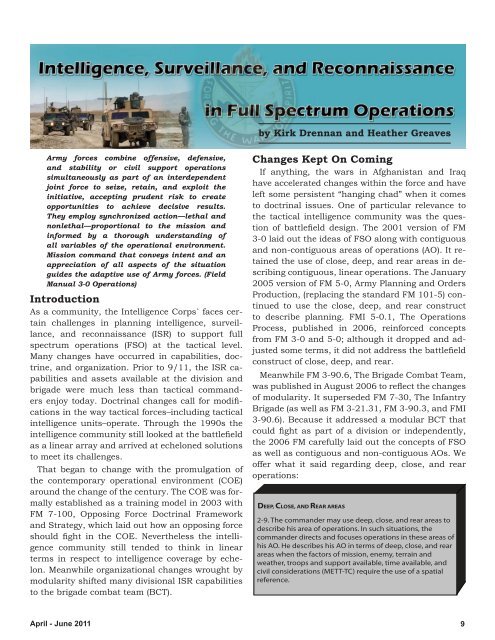George w. casey jr. - Federation of American Scientists
George w. casey jr. - Federation of American Scientists
George w. casey jr. - Federation of American Scientists
Create successful ePaper yourself
Turn your PDF publications into a flip-book with our unique Google optimized e-Paper software.
y Kirk Drennan and Heather Greaves<br />
Army forces combine <strong>of</strong>fensive, defensive,<br />
and stability or civil support operations<br />
simultaneously as part <strong>of</strong> an interdependent<br />
joint force to seize, retain, and exploit the<br />
initiative, accepting prudent risk to create<br />
opportunities to achieve decisive results.<br />
They employ synchronized action—lethal and<br />
nonlethal—proportional to the mission and<br />
informed by a thorough understanding <strong>of</strong><br />
all variables <strong>of</strong> the operational environment.<br />
Mission command that conveys intent and an<br />
appreciation <strong>of</strong> all aspects <strong>of</strong> the situation<br />
guides the adaptive use <strong>of</strong> Army forces. (Field<br />
Manual 3-0 Operations)<br />
Introduction<br />
As a community, the Intelligence Corps` faces certain<br />
challenges in planning intelligence, surveillance,<br />
and reconnaissance (ISR) to support full<br />
spectrum operations (FSO) at the tactical level.<br />
Many changes have occurred in capabilities, doctrine,<br />
and organization. Prior to 9/11, the ISR capabilities<br />
and assets available at the division and<br />
brigade were much less than tactical commanders<br />
enjoy today. Doctrinal changes call for modifications<br />
in the way tactical forces–including tactical<br />
intelligence units–operate. Through the 1990s the<br />
intelligence community still looked at the battlefield<br />
as a linear array and arrived at echeloned solutions<br />
to meet its challenges.<br />
That began to change with the promulgation <strong>of</strong><br />
the contemporary operational environment (COE)<br />
around the change <strong>of</strong> the century. The COE was formally<br />
established as a training model in 2003 with<br />
FM 7-100, Opposing Force Doctrinal Framework<br />
and Strategy, which laid out how an opposing force<br />
should fight in the COE. Nevertheless the intelligence<br />
community still tended to think in linear<br />
terms in respect to intelligence coverage by echelon.<br />
Meanwhile organizational changes wrought by<br />
modularity shifted many divisional ISR capabilities<br />
to the brigade combat team (BCT).<br />
Changes Kept On Coming<br />
If anything, the wars in Afghanistan and Iraq<br />
have accelerated changes within the force and have<br />
left some persistent “hanging chad” when it comes<br />
to doctrinal issues. One <strong>of</strong> particular relevance to<br />
the tactical intelligence community was the question<br />
<strong>of</strong> battlefield design. The 2001 version <strong>of</strong> FM<br />
3-0 laid out the ideas <strong>of</strong> FSO along with contiguous<br />
and non-contiguous areas <strong>of</strong> operations (AO). It retained<br />
the use <strong>of</strong> close, deep, and rear areas in describing<br />
contiguous, linear operations. The January<br />
2005 version <strong>of</strong> FM 5-0, Army Planning and Orders<br />
Production, (replacing the standard FM 101-5) continued<br />
to use the close, deep, and rear construct<br />
to describe planning. FMI 5-0.1, The Operations<br />
Process, published in 2006, reinforced concepts<br />
from FM 3-0 and 5-0; although it dropped and adjusted<br />
some terms, it did not address the battlefield<br />
construct <strong>of</strong> close, deep, and rear.<br />
Meanwhile FM 3-90.6, The Brigade Combat Team,<br />
was published in August 2006 to reflect the changes<br />
<strong>of</strong> modularity. It superseded FM 7-30, The Infantry<br />
Brigade (as well as FM 3-21.31, FM 3-90.3, and FMI<br />
3-90.6). Because it addressed a modular BCT that<br />
could fight as part <strong>of</strong> a division or independently,<br />
the 2006 FM carefully laid out the concepts <strong>of</strong> FSO<br />
as well as contiguous and non-contiguous AOs. We<br />
<strong>of</strong>fer what it said regarding deep, close, and rear<br />
operations:<br />
DEEP, CLOSE, AND REAR AREAS<br />
2-9. The commander may use deep, close, and rear areas to<br />
describe his area <strong>of</strong> operations. In such situations, the<br />
commander directs and focuses operations in these areas <strong>of</strong><br />
his AO. He describes his AO in terms <strong>of</strong> deep, close, and rear<br />
areas when the factors <strong>of</strong> mission, enemy, terrain and<br />
weather, troops and support available, time available, and<br />
civil considerations (METT-TC) require the use <strong>of</strong> a spatial<br />
reference.<br />
April - June 2011 9















